This is a Pahadi-style Gahat Ki Dal recipe. It is also known as Kulath dal or horse gram stew. It is a wholesome, hearty, and healthy Indian dal.
About Horse Gram
To many, the name at first name, horse gram, sounds weird. The whole legume seeds are fed to the cattle, which explains the story behind this name.
Horse gram is known as Gahat, Kulath, or Kulthi Dal.
Like many other native ingredients of Uttarakhand and other hilly terrains, Gahat is grown with many hardships on the terrace farms.
Horse Gram has a high nutritional value and tons of health benefits.
- It is high in protein
- It lowers blood sugar
- It reduces constipation
- It is a great antioxidant
- It helps in removing kidney stones
In short, it is a fantastic superfood recommended by many professional dieticians and nutritionists.
Pahadi Style Gahat Dal
I come from a Kumaoni family in Uttarakhand. My mother, who has spent a considerable part of her teen years in her paternal village – Paithani- greatly affection for local produce and Kumoni Cuisine.
During our growing years, one of her distant cousins, every year, before the first winter breeze, would send one bag full of Pahadi Gahat along with Pahadi Bhatt (black soybean) and Mandua flour.
Pahadi Gahat Ki Dal with bhaat (steamed rice) is a staple combination in our Kumaoni household. In a heavy traditional cast iron pot, Gahat Dal is stewed with aromatic ginger, garlic, and Jumbu/Jimbu (a local herb).
The gahat ki dal is slow-cooked for quite some time for the flavors to develop and to tease the senses of hungry goblins roaming around with its alluring aroma.
And at last time for the sizzling melodrama of Indian kitchen – tadka (tempering), with a ladle full of ghee, cumin, and herbs.
Ingredients Required
Horse Gram: It is a brown color legume commonly known as Gahat or Kulthi Ki Dal in India.
Herbs: Ginger, Garlic, Jumbu (Jimbu), Gandrain
Spices: Cumin Seeds, Asafoetida, Red Chili Powder, Turmeric Powder
Ghee: It balances the dal’s protein and gives it a delicious taste. Hence, I would not recommend using any other cooking oil or fat.
Rice Flour: A slurry or paste of rice flour with water gives a luscious texture to the gahat dal.
Other Ingredients: Salt, Green Chili, Water, Fresh Coriander Leaves
How To Make
Step 1) Clean, rinse, and soak the Gahat for 4 – 5 hours in water. Please note that the soaked water is used for cooking the dal and has a lot of nutrients (image 1).
Step 2) Add dal with water, green chili, grated ginger, garlic, salt, red chili, and turmeric powder in a pressure cooker. Stir it. Close the lid of the pressure cooker and place the whistle on it (images 2 & 3).
Step 3) Over low heat, cook the dal for 3 – 4 whistles. Let the pressure release naturally. Open the pressure cooker, and check dal for doneness. It should be fully cooked (image 4).
Step 4) Turn on the heat. Start simmering the dal over low heat.
Step 5) Make a slurry or paste of rice flour and water. Add it to the simmering dal along with Jumbo and Gandrain. Mix nicely. Continue simmering the Gahat Dal over low heat. Stirring occasionally and gently mash dal with the back of the spoon/ladle to thicken it.
Step 6) For tempering the dal, heat ghee in a small tadka pan, add cumin seeds once they crackle, add asafoetida, immediately add this tempering over the dal and mix nicely. Cover the dal with a lid.
Garnish with chopped coriander leaves. Serve Pahadi Gahat ki Dal with bhaat.
My Tried & True Tips
Horse Gram requires a soaking time of 4 – 5 hours before cooking. It can do more harm than good if cooked without soaking.
Jumbo and Gandrain are two local herbs from Uttarakhand. They are added to Gahat Dal for their aroma, taste, and medicinal properties.
Pahadi Gahat Dal tastes best when slow-cooked over low heat. I suggest for the best results, do not rush the whole process.
Rice Flour helps in thickening the dal and gives it a delicious texture. Do not use cornstarch or all-purpose flour.
Horse Gram is a high-protein legume. Hence, we add ghee (fat) spoonfuls to it for easy digestion.
Horse Gram has a very bland taste. Hence, the fresh herbs, spices, and ghee give all the taste to the dal.
In Kumaoni style Gahat Dal, we do not add onion, tomato, garam masala, or ginger garlic paste. If you skip the garlic, it is a fabulous no onion, no garlic dal recipe.
More Kumaoni Recipes
Subscribe to our weekly newsletter or follow us on Youtube for video recipes.
If you try this recipe and love it, please leave a comment and a rating. This helps us grow and reach other food lovers like you.
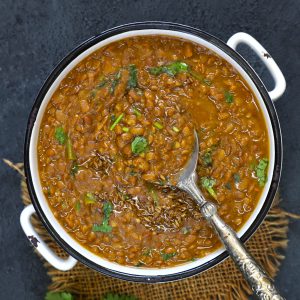
Pahadi Gahat Ki Dal Recipe
- Heavy Bottom Kadhai
Ingredients
- 1 Cup horse gram (gahat/kulthi)
- 2 chopped green chili
- 1 tablespoon chopped ginger
- 1 tablespoon garlic cloves
- ¼ teaspoon turmeric powder
- 1 teaspoon red chili powder
- 1 ¼ teaspoon salt or to taste
- 6 Cup water
- 1 teaspoon Jumbu (a local Kumaoni herb)
- 1 teaspoon Gandherin (a local Kumaoni herb)
- 1 tablespoon rice flour
For tempering
- 4 tablespoon ghee
- 2 teaspoon cumin seeds (jeera)
- ¼ teaspoon hing (asafoetida)
Instructions
- Clean, rinse, and soak the Gahat for 4 – 5 hours in water. Do not throw away the saoked water. It is used to cook the dal.
- Add dal with water, green chili, grated ginger, garlic, salt, red chili, and turmeric powder in a pressure cooker. Stir it. Close the lid of the pressure cooker and place the whistle on it.
- Over low heat, cook the dal for 3 – 4 whistles. Let the pressure release naturally. Open the pressure cooker, and check dal for doneness. It should be fully cooked.
- Turn on the heat. Start simmering the dal over low heat.
- Make a slurry of rice flour and water. Add it to the simmering dal along with Jumbo and Gandrain. Mix nicely. Continue simmering the Gahat Dal over low heat. Stirring occasionally and gently mash dal with the back of the spoon/ladle to thicken it.
- For tempering the dal, heat ghee in a small tadka pan, add cumin seeds once they crackle, add asafoetida, immediately add this tempering over the dal and mix nicely. Cover the dal with a lid.
- Garnish with chopped coriander leaves.
- Serve Pahadi Gahat ki Dal with bhaat.
Recipe Notes:
- Horse Gram requires a soaking time of 4 – 5 hours before cooking. It can do more harm than good if cooked without soaking.
- Jumbo and Gandrain are two local herbs from Uttarakhand. They are added to Gahat Dal for their aroma, taste, and medicinal properties. If not available, use one teaspoon of Kasuri Methi.
- Do not use cornstarch or all-purpose flour instead of rice flour slurry.

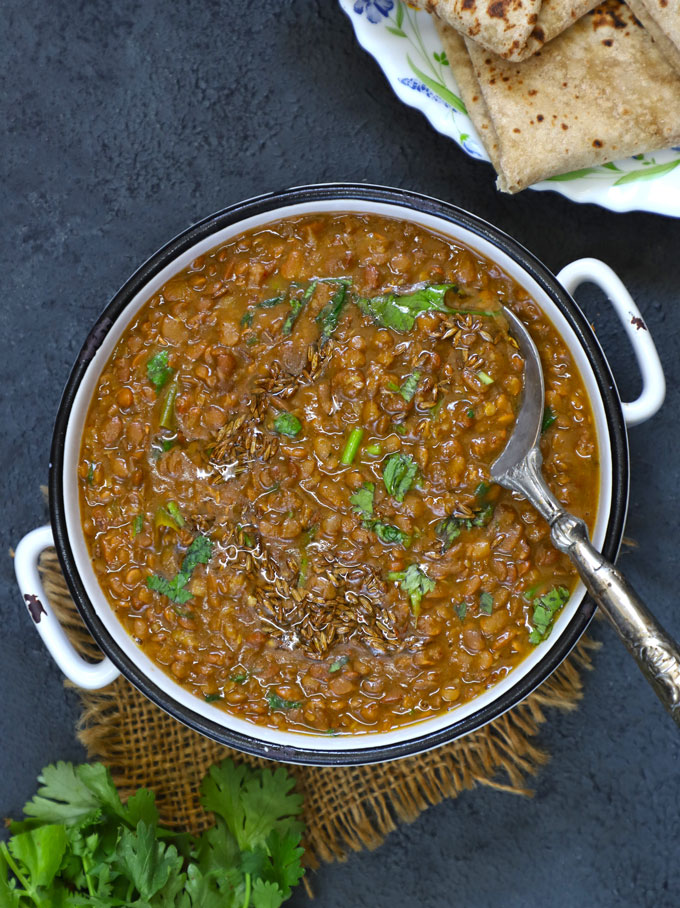
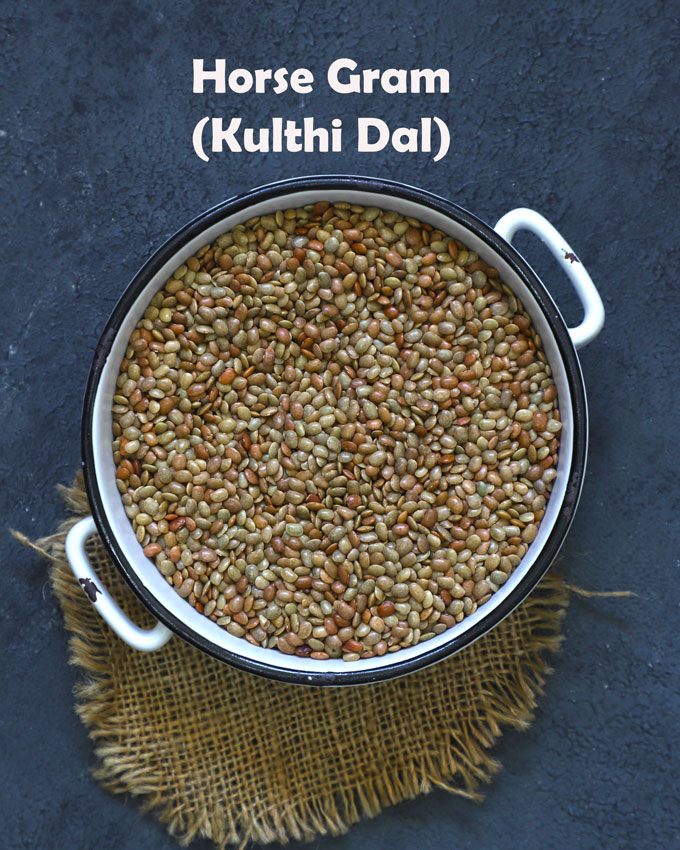
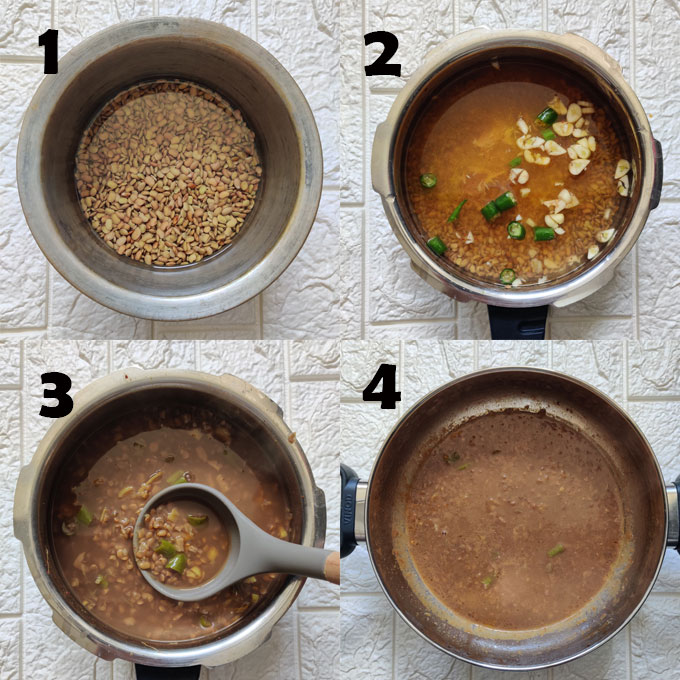
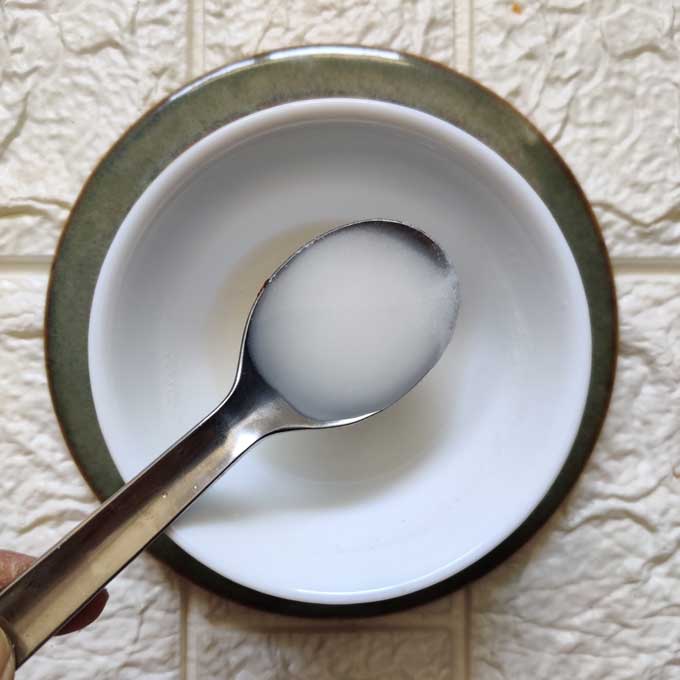
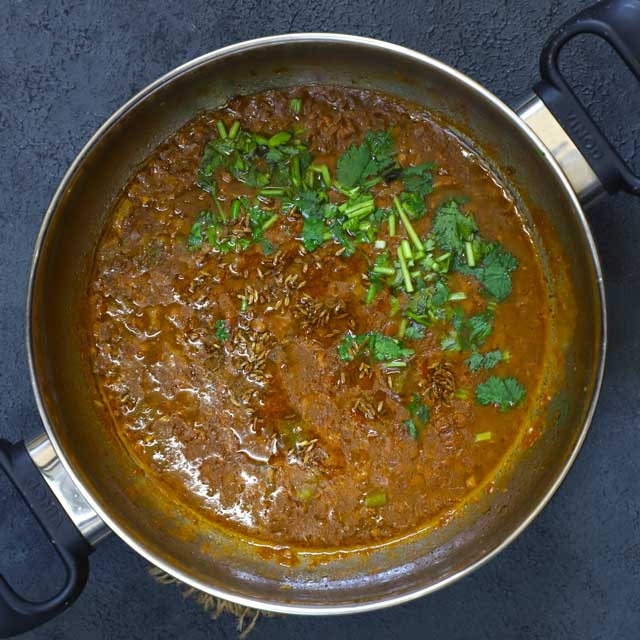
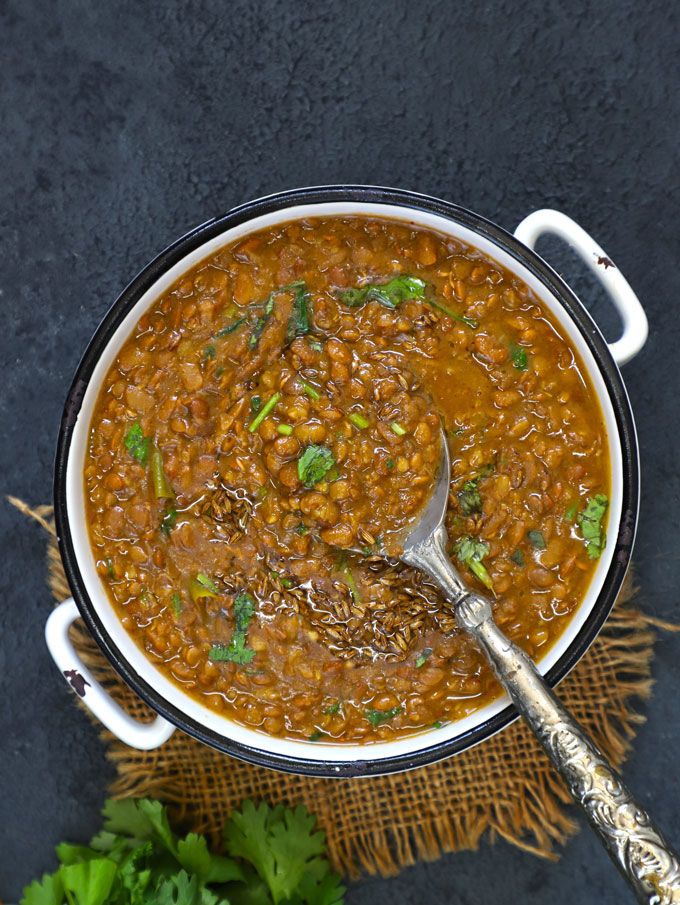
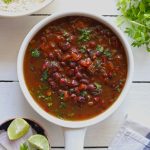
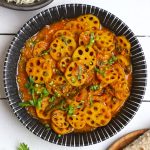
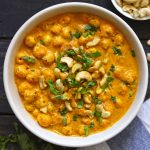
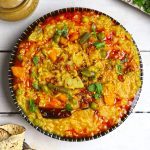
Uttpal K says
Beautifully put…
Deepa says
Ghaute-k Daau as we call it kumaoni!!
Beautifully penned. Loved the pictures.
Can you please put a picture of the pahadi spices jambhu , gadraiyein please?
Sharadha Sambasivan says
Amazing and simple recipe
santosh says
superb.. need more recipes like this
Hina Gujral says
thanks. I am so happy you like it.
Sujata says
Amazing recipes….
Hina Gujral says
Thank You!
namita says
simple n tasty recipe…
Hina Gujral says
That is the USP of Kumaoni Cuisine – simple, easy, and tasty
namita says
Easy n tasty recipe…
Arabind Binakar says
Where do i get jumbo dungaar
Hina Gujral says
Many online spice stores sell it online otherwise it is not a common ingredient.
Aishwarya says
Hey!
I loved the recipe! Everyone at home was happy. But I changed the recipe a bit. I added dal makhni masala to it, because I kept feeling anxious of sticking with your recipe because I didn’t know what it is supposed to taste like. When I cook something I HAVE to know what it tastes like, at least a descriptive idea of it. So that sense of taste and smell that I have from my memory guides me through the cooking process. But I loved the dal and will definitely give your exact recipe a try really soon! Thank you so much !
Hina Gujral says
So happy to know that your family enjoyed the dal.
Meenakshi says
Thank you, Hina ji, for the artistic writing you have done by making Pahari dishes, so that Pahari dishes will spread all over the world and remain alive for a long time and people will be aware of Pahari dishes! It is commendable to explain the method of cooking and explain it according to the local language!
Hina Gujral says
I am happy you like it.
Rachna Arora says
Awesome recipe, simple and easy. Do you have a recipe for cooking Bhat white as well as black. Got them a gift along with a mixed dal consisting of gahat, rajma , lobia and some more varieties from uttarakhand. Your recipes will be helpful 🙂
Hina Gujral says
Lovely! I am going to share it real soon.